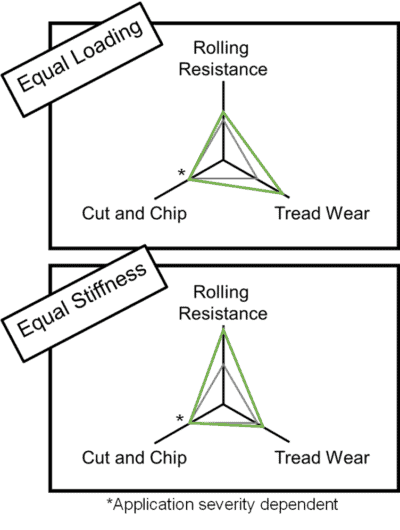BIRLA CARBON BLOG
INSIDER KNOWLEDGE FOR ALL THINGS CARBON BLACK
Addressing Tire Tread Compound Performance Challenges using Very High Structure Carbon Blacks
Reading Time: 2.75 minutes
Challenges in Tire Tread Compound Designing
The development of tire tread compounds is a challenging process that necessitates a careful balancing act between opposing performance parameters including rolling resistance, traction, and tread wear. Rubber compounders have a variety of obstacles to overcome in their quest to produce high-performance tire treads for both commercial and passenger vehicles that satisfy drivers’ varied needs and industry requirements.
The rolling resistance of a tire is a key focus in modern tire development, with a primary objective being to improve fuel economy. Enhancing fuel efficiency can be achieved by minimizing rolling resistance. To do this, one must perform a careful balancing act because lowering rolling resistance frequently necessitates making trade-offs with other factors, such traction.
The issue of tire wear has gained significant attention as a crucial issue in determining performance and environmental standards. As vehicles navigate roadways, the interaction between tires and road surfaces leads to the inevitable production of minuscule particles due to friction. Tire road wear particles (TRWP) consist of a diverse combination of rubber, plastic, metals, and various other substances. Their influence extends beyond road surfaces, resulting in a complex and wide-ranging performance and environmental impact. The biggest obstacle faced by compounders is to find the optimal compound that achieves a balance between fuel efficiency and overall tire performance.
Solutions from Birla Carbon Birla Carbon offers a series of carbon blacks with a range of particle size/surface area, featuring very high structure (VHS) levels. These carbon blacks are one technology approach to better balancing the contrary performance parameters for tire treads and can be implemented to enhance the abrasion resistance of tire treads and mitigate the energy loss associated with rolling resistance. The balance between abrasion performance and rolling resistance can be tailored by varying the compound implementation strategy of these types of carbon blacks.
Due to their significantly higher structures compared to standard grades of carbon back, when used as a direct substitution, such VHS carbon blacks, produce compounds with higher dynamic stiffness and reduced tan δ, which result in significantly improved abrasion performance versus standard ASTM carbon blacks. Conversely, if VHS carbon blacks are implemented at equal compound dynamic stiffness by adjusting the black loading vs standard ASTM carbon blacks, then even more significant reductions in tan δ, and therefore benefits in fuel efficiency can be achieved while also maintaining reasonable abrasion performance.
In brief, very high structure carbon blacks offer a flexible platform for balancing tire performance parameters such as abrasion resistance and rolling resistance. VHS carbon blacks are offered at different particle sizes, allowing implementation in a wide variety of tread compounds, as well as providing options for body/non-tread applications. VHS carbon blacks are particularly suited for long haul truck tire applications. Specific product examples are BC2013 in the 30 nm (N300 series) particle size range and BC2005 in the 20 nm (N200 series) particle size range.
Figure 1. Improvement in tread wear while implementing VHS carbon blacks (green line) verses ASTM carbon blacks (grey line) at equal loading and improvement in rolling resistance at equal stiffness.

Amrish Padmakumar
Amrish Padmakumar is a Senior Scientist at Birla Carbon where he is in charge of designing and creating rubber carbon blacks for use in both tire and non-tire rubber applications. His responsibilities include managing development projects from conception to full-scale commercialization. Amrish holds a dual master’s degree in chemistry and rubber technology. Recent academic achievements include a Ph.D. in Chemical Engineering from Australia’s University of Melbourne.
WANT TO LEARN MORE ABOUT CARBON BLACK AND THE PROPERTIES THAT MAKE IT IDEAL FOR YOUR PLASTICS, COATINGS, AND INKS APPLICATIONS?











Leave A Comment